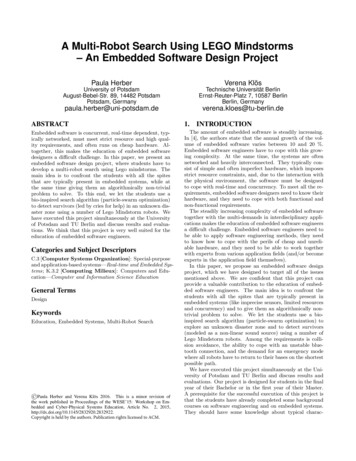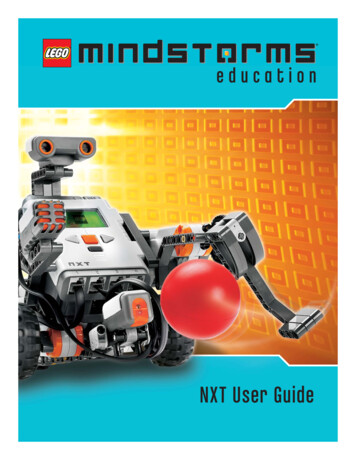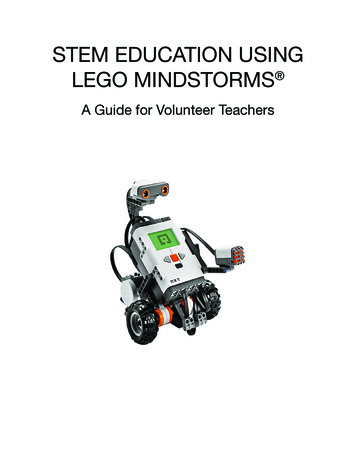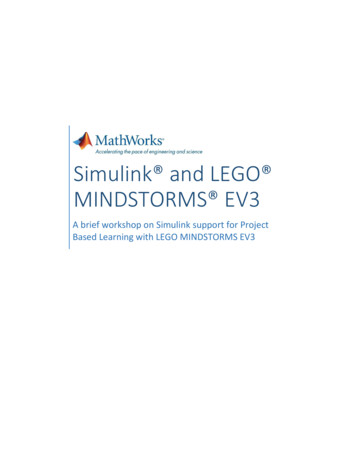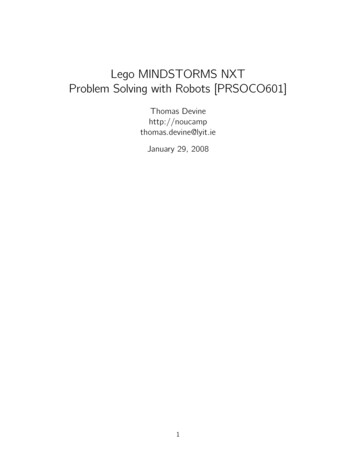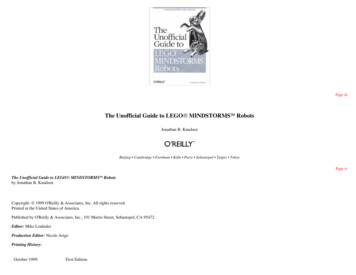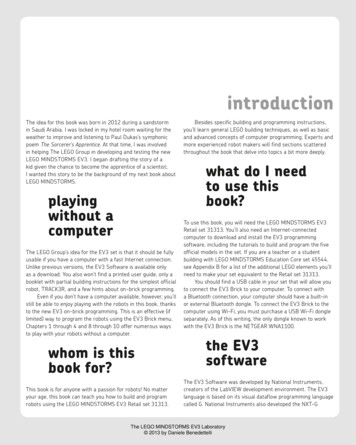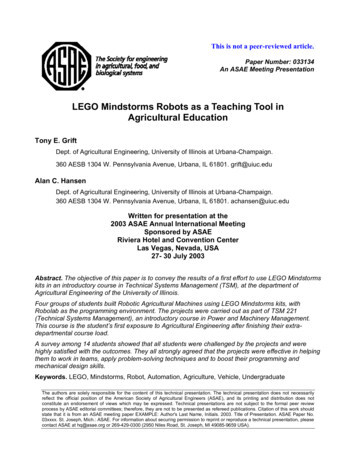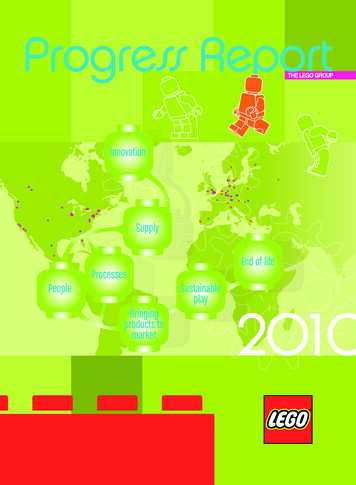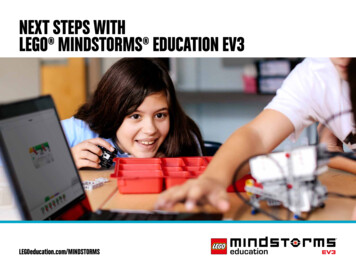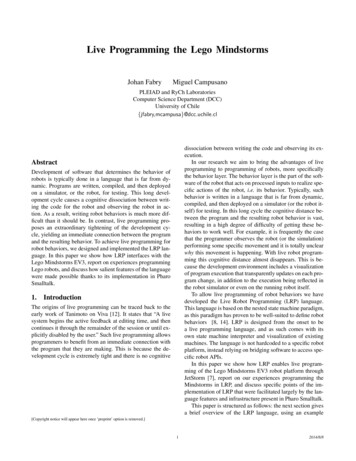
Transcription
Live Programming the Lego MindstormsJohan FabryMiguel CampusanoPLEIAD and RyCh LaboratoriesComputer Science Department (DCC)University of Chile{jfabry,mcampusa}@dcc.uchile.cldissociation between writing the code and observing its execution.In our research we aim to bring the advantages of liveprogramming to programming of robots, more specificallythe behavior layer. The behavior layer is the part of the software of the robot that acts on processed inputs to realize specific actions of the robot, i.e. its behavior. Typically, suchbehavior is written in a language that is far from dynamic,compiled, and then deployed on a simulator (or the robot itself) for testing. In this long cycle the cognitive distance between the program and the resulting robot behavior is vast,resulting in a high degree of difficulty of getting these behaviors to work well. For example, it is frequently the casethat the programmer observes the robot (or the simulation)performing some specific movement and it is totally unclearwhy this movement is happening. With live robot programming this cognitive distance almost disappears. This is because the development environment includes a visualizationof program execution that transparently updates on each program change, in addition to the execution being reflected inthe robot simulator or even on the running robot itself.To allow live programming of robot behaviors we havedeveloped the Live Robot Programming (LRP) language.This language is based on the nested state machine paradigm,as this paradigm has proven to be well-suited to define robotbehaviors [8, 14]. LRP is designed from the onset to bea live programming language, and as such comes with itsown state machine interpreter and visualization of existingmachines. The language is not hardcoded to a specific robotplatform, instead relying on bridging software to access specific robot APIs.In this paper we show how LRP enables live programming of the Lego Mindstorms EV3 robot platform throughJetStorm [7], report on our experiences programming theMindstorms in LRP, and discuss specific points of the implementation of LRP that were facilitated largely by the language features and infrastructure present in Pharo Smalltalk.This paper is structured as follows: the next section givesa brief overview of the LRP language, using an exampleAbstractDevelopment of software that determines the behavior ofrobots is typically done in a language that is far from dynamic. Programs are written, compiled, and then deployedon a simulator, or the robot, for testing. This long development cycle causes a cognitive dissociation between writing the code for the robot and observing the robot in action. As a result, writing robot behaviors is much more difficult than it should be. In contrast, live programming proposes an extraordinary tightening of the development cycle, yielding an immediate connection between the programand the resulting behavior. To achieve live programming forrobot behaviors, we designed and implemented the LRP language. In this paper we show how LRP interfaces with theLego Mindstorms EV3, report on experiences programmingLego robots, and discuss how salient features of the languagewere made possible thanks to its implementation in PharoSmalltalk.1.IntroductionThe origins of live programming can be traced back to theearly work of Tanimoto on Viva [12]. It states that “A livesystem begins the active feedback at editing time, and thencontinues it through the remainder of the session or until explicitly disabled by the user.” Such live programming allowsprogrammers to benefit from an immediate connection withthe program that they are making. This is because the development cycle is extremely tight and there is no cognitive[Copyright notice will appear here once ’preprint’ option is removed.]12014/8/8
Caster(hidden)behavior that also serves to illustrate elements of the rest ofthe paper. Section 3 reports on the bridge to the Mindstormsand our experience in using it to program robot behaviors.Following this, Section 4 highlights specific elements ofPharo Smalltalk that made the implementation possible. Thepaper then presents related work, future work and concludes.2.The“Brick”Left drivenwheelUltrasonicSensorThe LRP LanguageLive Robot Programming (LRP) is a live programming,nested state machine based language with an associated interpreter and visualization, implemented in Pharo. The features of LRP are designed for robot programming, yet thelanguage is not hardcoded to a specific robot platform. LRPenables the use of APIs of specific robot platforms and assuch comes with bridges towards the Robot Operating System (ROS) [5], and now also to the Mindstorms EV3 [13]through JetStorm [7], as will be discussed in Section 3.A complete description of LRP is outside of the scope ofthis paper, we only give a brief overview of its features here,and refer to its website http://pleiad.cl/LRP and otherpublished work [4] for more details.The main language features of LRP are:WiFiDongleTouchSensorsRight drivenwheelFigure 1. The Lego Mindstorms robot of the explorer behavior example. Machines with states and different kinds of transitions.ample of such a robot constructed using the Mindstorms isshown in Figure 1.The first part of the code, below, takes care of connectingthe program to the Mindstorms by reifying the differentmotors and sensors as variables: Transitions that can occur on events, occur after a timeoutor occur automatically after a state is entered. Events are explicitly defined and trigger if their includedpiece of code, called an action, evaluates to true.1 States can have actions that are run when entering the2state, leaving the state, or when the state is active.34 States can define state machines, which enables nesting.5 Machines can define variables, and these are accesible( var( var( var( var( varmotA : [ LRPEV3Bridge motorA ] )motB : [ LRPEV3Bridge motorD ] )u l t r a : [ LRPEV3Bridge s e n s o r 3 ] )r i g h t t o u c h : [ LRPEV3Bridge s e n s o r 1 ] )l e f t t o u c h : [ LRPEV3Bridge s e n s o r 4 ] )Five variables are declared and immediately initialized,which is mandatory. In LRP, code between square bracketsare actions, i.e. Smalltalk blocks. The class LRPEV3Bridgeis a facade class responsible for connection to the Mindstorms and making the different sensors and motors available. This is in essence how LRP code interacts with specificrobot platforms: reifying relevant elements as variables andsubsequently interacting with these variables in actions, i.e.in Smalltalk code.With the variables defined, the definition of the statemachine for the behavior starts as below. The machine iscalled Dora (for Dora the Explorer), and initially defines twostates and two transitions:inside actions if the variable is lexically in scope.LRP has its own language syntax and the interpreter is,in essence, a plain state machine interpreter that consumesthe ASTs of the program and provides the standard nestedstate machine semantics. The only remarkable element isthat actions are actually Smalltalk blocks that are compiledafter the program is parsed. This process is discussed inSection 4.1.To show the syntax of the language, clarify how it allowsfor robot programming on the Mindstorms and provide example material for Sections 3 and 4, we now show and discuss the code for a simple behavior. The behavior is a simplespace exploring behavior where the robot goes forward untilit encounters a wall, where it backs up, turns a bit, and againgoes forward. This behavior is ment to run on a differentialdrive robot1 with the (ultrasonic) distance sensor pointingforward and a touch sensor on both front corners. An ex-67891011121 Typicallya tricycle that has 2 driven wheels, each with its own motor, andthe third wheel being a caster13142( machine Dora( state forward( onentry[ motA v a l u e s t a r t A t S p e e d : 5 5 .motB v a l u e s t a r t A t S p e e d : 5 5 . ] )( o n e x i t [ motA v a l u e s t o p . motB v a l u e s t o p ] ) )( state looking )( ontime 600 f o r w a r d l o o k i n g t l o o k )( ontime 120 l o o k i n g f o r w a r d t f o r w a r d )2014/8/8
Lines 7 through 11 specify the forward state. The blockin lines 9 and 10 is executed whenever this state is entered.As it represents the robot moving forward, both motors arestarted at 55% of top speed. The block in line 11 is executedwhenever the robot leaves the forward state and thereforestops both motors. The looking state in line 12 does notdefine any actions.Note that both blocks use the motor variables definedin lines 1 and 2, and always send them the value message first. This is because all variables are in fact SmalltalkValueHolders, as we will discuss in Section 4.2.Lines 13 and 14 show two timeout transitions. The numbers given in the transitions specify a timeout in milliseconds, starting from when the source state is entered, and trigger after the timeout is reached. The text of the remainder ofthe transition specifies, respectively source state, destinationstate, and transition name.With this code in place, the robot alternates betweenmoving forward for 0.6 seconds, and then waiting for 0.12seconds. In those 0.12 seconds the three different sensorsare polled (which takes a bit less than 0.12 seconds), as isdefined in the next three lines of code:151617181920This code is sufficient for implementing the explorer behavior. When editing this code in LRP, the interpreter is always running and updating the interpreted machine whilethe programmer types, and moreover the LRP window,shown in Figure 2, displays the tree of current machines, thecontents of variables, and a visualization of the machine. Thevisualization highlights the currently active state (lookingin the figure) and the last taken transition. Also, variablescan be inspected and their values set.3.LRP is at its core a live programming language for nestedstate machines. It is implemented in Pharo, using PetitParser [10] as the parser generator, Roassal2 [2] for the visualization of the state machines, and Spec [11] to build theuser interface.The language features have been designed with the useas a robotics behavior layer in mind, yet the language itself does not have any intrinsic robotics support. This responsibility instead lies on bridging software that spans thegap to specific robot platforms. Currently, LRP comes witha bridge to ROS [5], and the Lego Mindstorms EV3 [13] viaJetStorm [7]. In this section we present the latter and discussa practical issue we faced programming the Mindstorms.( e v e n t w a l l [ u l t r a v a l u e r e a d 20 ] )( event rightbump [ r i g h t t o u c h value read 1 ] )( event leftbump [ l e f t t o u c h value read 1 ] )( on w a l l l o o k i n g b a c k u p t b a c k u p )( on r i g h t b u m p l o o k i n g b a c k u p t r t b a c k u p )( on l e f t b u m p l o o k i n g b a c k u p t l t b a c k u p )3.1222324252627282930313233Hard- and SoftwareThe Lego Mindstorms EV3 [13] is the third iteration of theLego Mindstorms line. The embedded system of the set iscalled the brick, and it features an 300 Mhz ARM9-basedprocessor, 64MB of RAM which runs Linux 2.6.x. The sensor package (in the education version) is an ultrasound distance sensor, two touch sensors, a color sensor and a gyroscopic sensor. Three motors are supplied, each motor with abuilt-in rotation sensor. Last but not least, a comprehensiveset of Lego bricks are included, enabling the speedy construction of a wide variety of robot hardware.The brick also includes an USB port, and support for onespecific WiFi dongle, which allows the robot to be remotecontrolled via WiFi. JetStorm [7] is a Pharo package thatallows for the remote control of the EV3 by reifying thebrick, sensors and motors as Smalltalk objects that can besent messages. For example, sending the startAtSpeed:55 message to a motor object causes a command to be sentto the brick to start the corresponding motor at 55% of thetop speed the motor is capable of.The LRP Mindstorms bridge currently consists of a facade class LRPEV3Bridge that is placed in front of JetStorm.This class provides features for connecting to the brick overIP and retrieving the various sensors and motors connectedto the brick. The latter is shown in lines 1 through 5 of theexample program. If there is no IP connection to the brickwhen a sensor or motor is retrieved, the user is promptedfor the IP address of the brick and a connection is set up.Lines 15 through 17 define events. The interpreter willevaluate the actions for these events only if triggering theseevents can cause a transition to occur. In this case, the transitions on line 18 through 20 may occur as they start from thelooking state and go to a backup state, defined below.In summary: if none of the events trigger, the robot goesto the forward state, otherwise it goes to the backup state.21Bridging LRP to Robot Hardware:Controlling the Mindstorms( s t a t e backup( onentry[ motA v a l u e s t a r t A t S p e e d : 32.motB v a l u e s t a r t A t S p e e d : 32. ] )( o n e x i t [ motA v a l u e s t o p . motB v a l u e s t o p ] ) )( ontime 300 b a c k u p t u r n t t u r n )( s t a t e t u r n ( onentry[ motorA v a l u e s t a r t A t S p e e d : 32.motorB v a l u e s t a r t A t S p e e d : 3 2 . ] )( o n e x i t [ motA v a l u e s t o p . motB v a l u e s t o p ] ) )( ontime 700 t u r n f o r w a r d t t f o r w a r d ))( spawn Dora f o r w a r d )The above backup, and turn states, together with thet-turn and t-tforward transitions implement the behavior of backing up, turning around, and resuming moving forward. The last line of code specifies that the Dora machineshould be started by the interpreter and that its initial stateis forward. This spawn statement also can be used as anaction in an onentry of a state, which means that when thisstate is entered the specified machine should be interpreted.32014/8/8
Figure 2. The LRP editor showing part of the example of this text: the Dora machine.entire experience, and that is the presence of network lag onrobot commands.Sending commands from a computer to the brick over thenetwork and waiting for a reply causes a notable delay ininteractions of the LRP interpreter with the robot. Informalmicrobenchmarks have shown us that it takes approximately30 microseconds for a sensor read operation to return thesensor’s value, and the same time to instruct a motor to start.While this time lag may seem negligible, this turns out notto be the case. For example, in line 15 to 17 of the examplecode, three sensors are polled, which therefore takes approximately 120 microseconds. This is a noticeable delay, and atime in which the robot may advance a significant distance.For the example the distance traveled in that time is 5 cm,with the motors at 55% of top speed.It is exactly because of this delay that the Dora behavioris structured in a moving and a looking phase. The robotfirst moves for a distance that is deemed ‘safe’, and thenstops to verify if the wall is too close. This results in astuttering behavior of the robot that is quite noticeable. Ifreading sensors were immediate, there would be no needfor a looking state: the robot would continuously poll thesensors for their data. As a result the robot would not stutterand be able to explore at a higher overall speed.We have experience with programming robots on the predecessor of the EV3, having software run on the brick itself by using the leJOS [6] Java to NXT cross-compiler.While the old brick has significantly inferior hardware, thissetup is orders of magnitude more responsive, resulting inrobot behaviors that are much more fluid and faster. Consequently, Dora-like behaviors for example can be executedmuch faster. Note that these experiments were in Java codeThe various sensors and motors that are retrieved are objectsprovided by JetStorm, no facade is placed in front of them.In our experience, the one, minimal, facade class hasproven to be sufficient to allow small experiments with theMindstorms. We are however faced with the situation thatLRP may grow to have multiple bridges to many differentrobot API’s. For example the API to ROS is quite different.It requires movement vectors to be sent, and their interpretation by the robot eventually causes the respective motorsto operate. A wide disparity in how these APIs are exposedto LRP programmers will cause a tight coupling of LRPprograms to a specific API and prohibit reuse of behaviorsacross robot platforms, effectively splintering the languagein different versions for different APIs. It would therefore bebeneficial to have at least some basic uniformity of the APIthat the different LRP bridges expose, at least when considering the lowest common denominator of the APIs. Consequently this could possibly require the EV3 Bridge facadeto increase in complexity, translating the common API callsto JetStorm calls. We consider the study of such a commonAPI as future work.3.2Experience Report: The Issue of LagLive Programming of the Lego Mindstorms is a very satisfying experience. It is possible to quickly prototype reasonably complex behaviors, while benefitting from the immediate feedback that live programming brings. We are able tochange the behavior of a robot while it is running and activein its environment, and the visualization of the state machineallows us to immediately establish in which state the robot isand how it got there. There is only one negative point in the42014/8/8
and hence did not suffer from any overhead of the LRP interpreter. The overhead of LRP is however almost negligible:in informal tests, the overhead for evaluating events and executing state transitions has been benchmarked to be aroundone millisecond.Ideally the robot behavior software would therefore runlocally on the EV3 itself. There is however, as yet, no support in Pharo for running on the EV3. As a point of reference,only recently (April 2014) has the first beta release of leJOSon the EV3 been made available. We have not yet been ableto experiment with it, nor do we have the resources requiredto reimplement the LRP interpreter in leJOS.4.a BlockClosure that has references to all the variables inscope and hence just needs to be sent the value message toexecute.The process of compiling the AST of an action block isas follows:1. a Dictionary is created of all variables in scope, takinginto account shadowing of variables.2. Text for the signature for a method is created of the formcaptureV:V:V:, taking as many V: arguments as thenumber of variables in the dictionary.3. The names of the parameters of this signature are the keysin the dictionary. In the body of the method, the LRPvariables are hence in scope of the Smalltalk code.Implementing LRPThe interpreter of LRP is at its core a plain interpreter implementation for nested state machines, extended in two waysfor live programming [4]. First it is robust with respect toincomplete programs and keeps on executing in the face oferrors. Second it is able to modify the state machine whileit is running, adding and removing elements without alwaysrequiring a restart.There are two pieces of the implementation of the interpreter that we discuss here, as they show how the useof Smalltalk has aided us in its implementation, what arelimitations due to the implementation and how we plan toaddress them. These two elements are compilation of theblocks and variables as ValueHolders.4.14. The signature is appended with the string ’ [1]’ andthis complete method definition string is parsed.5. In the resulting AST method, the subtree for ’[1]’ isswapped with the AST of the block to compile.6. This method AST is compiled.7. The resulting method is invoked, passing it the valuesof the variables in the correct order. This causes theBlockClosure to capture variable references such thatthey may be used inside the code of the action.For example, let us consider the onentry block of lines 9and 10 of the Dora example. The result of step 5 is the ASTfor the following:Compiling the Blocks1Actions are used to connect LRP to the API of the specificrobot platform. They also may need to perform any kind ofcomputation on sensor inputs and the state of variables toestablish whether events occur, and hence may also needto update variables at some point. As a result we foundit a natural choice to allow actions to have the full powerof Smalltalk available and hence have them be Smalltalkblocks.Having actions as blocks however raises issues of performance. While the behavioral layer is not a time-criticalelement in the software of the robot, it does form part of acomputation chain that goes from sensor readings up to actuator actions. As such, any overhead that it adds in this process does have effect on the performance of the robot. Forthis reason, we decided that the overhead of executing actions must be minimal. Hence, in the interpreter actions arecompiled blocks: to run them only the value message needsto be sent.Parsing in LRP is performed by PetitParser [10], andaction blocks are also parsed, using the Smalltalk parserthat is part of PetitParser. As a result, when the interpreteris passed the AST of the state machine to interpret, theseblocks have the form of ASTs. The interpreter traversesthe complete AST for the program and compiles all actionblocks. The result of the compilation of an action block is234captureV :V:ˆ [ motAmotBmotB V : u l t r a V : r i g h t t o u c hmotA V : l e f t t o u c hvalue startAtSpeed : 55.v a l u e s t a r t A t S p e e d : 55 ]Step 6 yields a CompiledMethod for the above, i.e. amethod whose execution returns the BlockClosure thatcorresponds to the action (lines 3 and 4). In step 7, thismethod is invoked with as arguments the values of the variables motB, ultra, righttouch, motA, lefttouch. Thereturned BlockClosure has hence captured the referencesfor the variables it uses (motA and motB). This allows theaction to be executed by simply sending the value messageto this BlockClosure.The compilation of action blocks has turned out to bequite straightforward to implement, taking only about 20lines of code (of arguably low complexity). We consider thatbeing able to achieve such a complex task so succinctly is atestament to the power and flexibility of Pharo Smalltalk.There are however two downsides to the current implementation. Firstly, the method that is compiled has no classand an incorrect source code pointer. In our experience thishas caused issues when programming: the block cannot beprinted, the debugger does not work correctly and in somecases even primitive error handling fails, causing Pharo tocrash. An important avenue of future work is to improvethe compilation process such that these issues are addressed.52014/8/8
Secondly, methods can only take up to 16 arguments. Consequently, if there are more than 16 arguments in scope, compilation of the action block fails. A possible mitigation ofthis issue would be to perform a semantic analysis of theblock to establish which variables are effectively used insidethe block and only pass these as arguments in step 2,3, and7 above. We also consider this as future work.the variable, and setting the value of a variable is using thevalue: message instead of normal assignment.Our experience has shown in practice that in the beginning of writing LRP code it is easily forgotten that variables are ValueHolders, leading to widespread errors inbehaviors. Such errors are however quickly revealed: simple variable accesses usually already cause problems as theValueHolder class implements few messages. We are planning transparent use of ValueHolders, i.e. not requiring theuse of the value and value: messages, as future work. Wehave first considered source code manipulation of the codein the block to automatically transform accesses and modifications to the use of this messages. This however does notaddress the issue of the variables being used and modifiedoutside of the block, e.g. when they are passed as methodparameters. A second possible path would be to try the newSlots mechanism. We would have variables as slot instancevariables of a purpose-built class. The slot reading and writing mechanism would then implement the extra indirectionthat is currently achieved by the ValueHolders. As the Slotsmechanism has not been fully implemented its suitability ishowever yet to be determined.In summary We were able to incorporate the full powerof an OO language in our state machine-based languagethanks to the fact that we have straightforward access to thefollowing: a parser of Smalltalk expressions that produces ASTs, ASTs of methods allowing for their compilation at run-time, isolated from a class definition, blocks that capture the arguments of their enclosingmethod when they are created.4.2LRP Variables are ValueHoldersIn LRP, variables are key to interact with specific robot platforms. This is because they are used to reify API elementsfrom these platforms and the code in actions interacts withthese elements. For example, in the Dora example above, actions start and stop motors and poll sensors. Variables however serve as more than that, and this can be already seen inthe Dora example. The example contains many magic numbers, e.g. motor speeds, minimal wall distance (in line 15),and timeouts for the different transitions. All these numberscan (and actually should) be replaced by the use of variables, turning these magic numbers into robot calibrationconstants. Beyond cleaning up the code, this has as consequence that they can then be modified in the LRP editorwhile the program runs, effectively recalibrating the robotas it runs. Lastly, if the turning time on line 31 would be avariable, it could contain a random number that is set every time a turn is about to begin. This randomizes the turns,making the exploring behavior immune to being stuck in aloop. Because all of the above reasons, variables must trulybe mutable.Yet these variables are used by three different entities:the original program AST that contains the result of variable initialization, the LRP editor, and the different actionsthat use these variables. Recall that these blocks get passedthese variables by reference when they are constructed, asdiscussed in Section 4.1. As a consequence, any change tothe values of variables is invisible to these blocks! This is because changes to the values do not affect the references thatwere passed to the blocks as they were constructed. Hencevariables may not be changed.To address the issue that values of variables may not bechanged yet at the same time they must be mutable, we havemade use of ValueHolders. Every variable is a ValueHolderthat contains the value. This however entails that reading thevalue of a variable requires sending the value message toIn summary We required the use of a double indirectionto be able to have mutable variables, and the ValueHoldermechanism has shown to be a fitting solution. Requiring theuse of value and value: messages in actions is howeversuboptimal, and we are planning solutions to this issue.5.Related WorkConsidering robot behaviors using nested state machines,two languages and tools are well-known: The Kouretes Statechart Editor (KSE) [14] and XABSL [8]. In KSE state machines are graphically edited, with an option to start from atext-based description. The tool then follows a model-drivenprocess to generates the executable code for these machines.XABSL is text-based, using an XML representation of thestate machines. A variety of support tools are present, forexample, a tool that creates (static) diagrams of the machine.None of the languages above provide any support for liveprogramming, and the live programming languages belowdo not consider state machines as their computational model.Live programming was first proposed by Tanimoto [12].The language presented in that work is VIVA, a visual programming language for image manipulation. More recently,McDirmid proposed the SuperGlue language [9], based ondataflow programming and extended with object-orientedconstructs. Live programming of the UI has been proposedby Burckhard et al. [3], by adding specific features for liveUI construction to an existing programming language. Thekeynote of Victor [15] shows multiple live programmingexamples in Javascript, producing pictures, animations andgames. A recent addition to live programming is the Swiftlanguage by Apple [1], which allows for live programmingin specific workspaces called Playgrounds.62014/8/8
6.Conclusion and Future Workin Artificial Intelligence - IBERAMIA 2014, number 8864 inLecture Notes in Computer Science. Springer Verlag, 2014.In this paper we have reported on our first experiences ofwriting Live Robot Programming (LRP) programs for theMindstorms EV3, and detailed how some of the features ofPharo Smalltalk allowed us to accomplish its implementation.We first gave a brief overview of LRP through the use ofan example program. The program implements a space exploration behavior on a differential drive robot constructedusing the Mindstorms (illustrated in Figure 1). We then discussed the LRP bridge to the Mindstorms. LRP allows forthe live programming of robot behaviors, yet is not linkedto a specific robot platform, instead relying on such bridging software. This was followed by an experience report thatfocused on how the lag in sending commands to the EV3negatively impacts robot performance. We then discussedhow specific features of Smalltalk have aided in the construction of the LRP interpreter, more specifically the parsing and AST manipulation and compilation support, blocksand ValueHolders.There are multiple avenues of future work, which we havediscussed in some detail along this text. In summary, theseavenues consist of the study of a minimal common API forthe bridges to different robot platforms, improvements of thecompilation process of action blo
machines. The language is not hardcoded to a specific robot platform, instead relying on bridging software to access spe-cific robot APIs. In this paper we show how LRP enables live program-ming of the Lego Mindstorms EV3 robot platform throug
